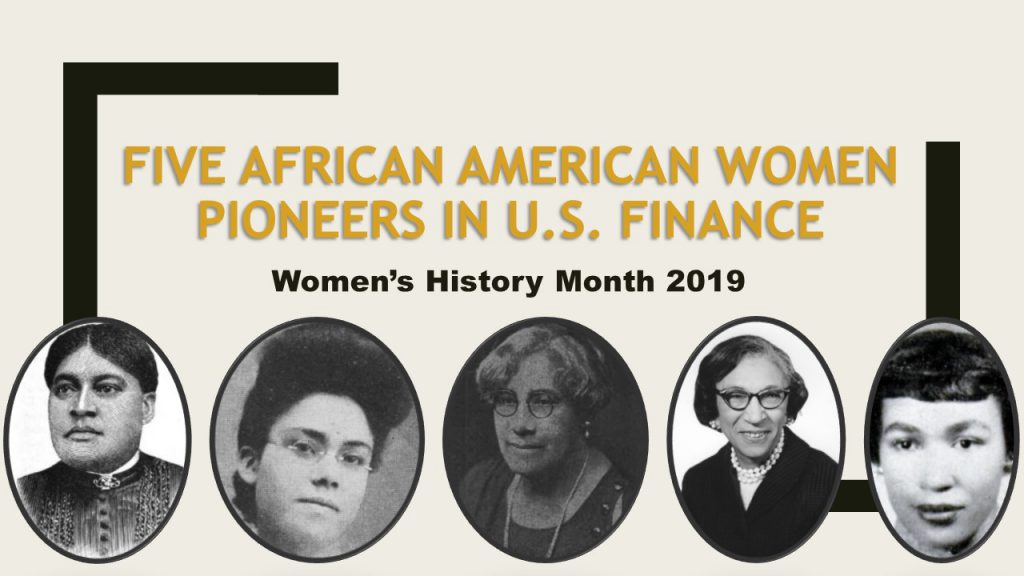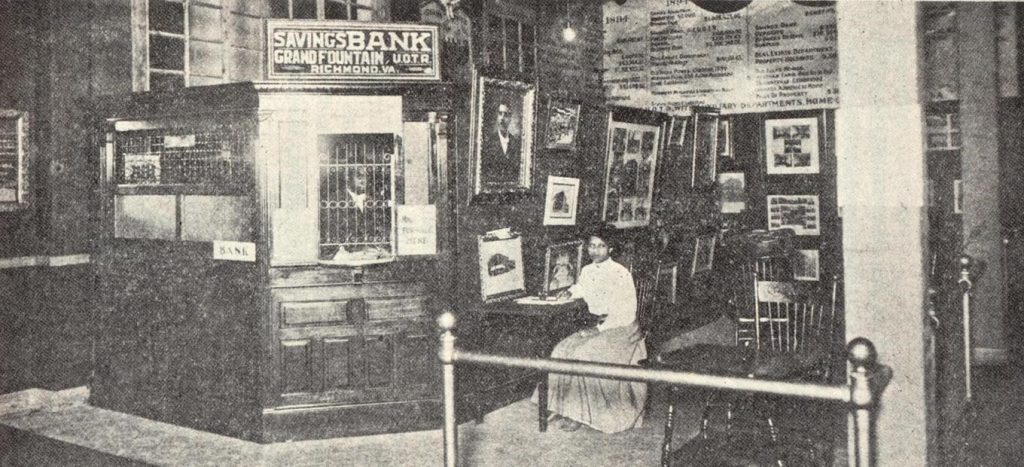Five African American Women Pioneers in U.S. Finance
Shennette Garrett-Scott

Between 1888 and 1930, African Americans opened more than a hundred banks and thousands of other financial institutions. One of those institutions was St. Luke Bank in Richmond, Virginia: the first and only bank run by black women. In her new book, Banking on Freedom: Black Women in U.S. Finance Before the New Deal, Shennette Garrett-Scott offers an unparalleled account of how black women carved out economic, social, and political power and illustrates how race and gender shaped modern capitalism. In today’s guest post, she introduces us to five African American women pioneers in U.S finance.
Eliza Allen: Board Member of First African American Bank

Eliza Allen was the only woman listed on the charter of the True Reformers Savings Bank (1888-1910), the first chartered African American-owned bank in the United States. Born enslaved in Westmoreland County, Virginia, around 1840, Allen joined the True Reformers when William W. Browne moved the nearly moribund order to Richmond in late 1880. She organized one of the first three fountains, as the Reformers’ local groups were called.
Her success in organizing large fountains for a small, relatively unknown organization attests to her long history organizing and running secret societies as an enslaved woman. Allen organized several secret societies among enslaved women, including the Consolation Sisters and Sisters of Usefulness. After emancipation, Allen and her family moved to Petersburg, Virginia. Like many African American women, she worked as a laundress.
The autonomy that washing for pay allowed Allen also permitted her time to devote to African American economic self-help organizations like secret societies. She occupied an elite stratum of women who were able to balance high-ranking, influential positions in numerous orders, including the Eastern Star, Tents of the Gidding and Jolliffe Union, and Independent Order of St. Luke. The tireless efforts and committed leadership of women like Allen allowed many of the most popular societies to build on the foundation of mutual aid, benevolence, and burial aid societies laid during slavery to create strong banks and insurance organizations in freedom.

Mabel Z. Mollison: First Woman Bank Cashier
Mabel Z. Mollison served as cashier of the Lincoln Savings Bank (1892-1908) in Vicksburg, Mississippi, making her the first African American woman and arguably the first woman to serve as cashier of a bank. One of the seven children of attorney and businessman William and homemaker Ida T. Welbourne Mollison of Vicksburg, Mollison completed her formal business education at Oberlin Business College.
The Lincoln Savings Bank began as the Knights of Honor Savings Bank in 1892, the first African American-owned bank in Mississippi and the second African American-owned fraternal bank established in the United States. In 1902, the bank reorganized as the Knights of Honor of the World Savings Bank, in part to distinguish it from the white fraternal Knights of Honor. Mollison became cashier of the reorganized bank. In 1903, the board changed the name once again to Lincoln Savings Bank to honor the fortieth anniversary of the Emancipation Proclamation.
In 1904, the bank moved from Vicksburg to Greenville, and a year later, Lincoln Savings was among the charter members of the Mississippi Negro Bankers Association. In addition to working as the bank’s cashier, Mollison worked as a stenographer and also taught stenography and other business clerical skills. By 1900, only a handful of U.S. banks had ladies departments, which were separate spaces where women could conduct their banking business.
Few women worked in banks—even in those with ladies departments. As cashier, Mollison held the most important position in the bank. The cashier oversaw all the financial transactions of the bank and served as the public face of the bank. Her desire to make a mark in the business and financial world reflected African American women’s desire to play important roles in the U.S. business and banking.
Lillian H. Payne: The Banker’s Banker
While Maggie Lena Walker enjoys widespread renown as the first African American woman to organize and lead a bank, Walker relied on Lillian Harris Payne as her right hand. Payne was born in 1867 and worked as teacher. Payne first worked with Walker in the Woman’s Union, a cooperative society organized in the 1890s comprised entirely of African American women.
The Woman’s Union operated an insurance office, grocery store, and rooming house. Payne placed among the tiny staff of four women, handpicked by Walker, to revive the Independent Order of St. Luke (IOSL) in 1899. Payne served as editor of the St. Luke Herald, the IOSL’s official organ. Payne used the newspaper to not only highlight the membership and business of the IOSL but alsospeak out on pressing political and social issues of the day.
Payne served on the Board of Directors of the St. Luke Bank (1903-1929, renamed Consolidated Bank and Trust 1929-2011) from 1903 to her retirement in the 1940s. Payne led the Finance Committee, which underwrote loan applications, for more than four decades. By the 1920s, more than 600 St. Luke Bank customers had taken out and paid in full their home mortgages. Payne’s role in the bank helped thousands of African Americans around the country achieve part of their American Dream.
Viola Turner: Black Wall Street’s Million-Dollar Investor
After World War II, African American corporations remained slow to recognize women’s contributions to their bottom lines, but a few women emerged as valuable assets. Viola Mitchell Turner was born in 1900 in Macon, Georgia. She attended the business school at Morris Brown College in Atlanta. She began working as a cashier-clerk at the North Carolina Mutual Insurance Company’s branch office in Oklahoma City in late 1920.
Turner moved to Durham, North Carolina, in 1924 and began working at the insurance company’s headquarters on Parrish Street, also known as the Black Wall Street. As a secretary to the company’s treasurer, her investment advice and portfolio management earned North Carolina Mutual over a million dollars. Her financial acumen placed her among the savviest women investors in the country. Wall Street brokers sought Turner out, bypassing many male executives and employees of the company to speak directly to Turner, who officially was only the secretary.
Early on, some men in the company patronized her investment portfolio as Turner’s “little project.” She would not have considered herself a feminist, but she pushed for equal pay and treatment for female employees. In 1957, she was elected Treasurer and later Vice President of North Carolina Mutual, becoming its first woman executive. She retired in 1965.
Lilla St. John: The First African American Woman Licensed Stock Broker
Lilla (also Lilly) St. John became the African American woman to pass the New York Stock Exchange licensing examination in 1953. Born in 1923 to Ida and Henry Johnson, St. John hosted her own music television show on a local Milwaukee station before delving into investing.
She began work as an investment counselor with Openheimer & Company, an aggressive Wall Street investment firm founded in 1950 by Max Oppenheimer. Little else is known of St. John, but her efforts highlight the small but growing numbers of African American women seeking more formal roles in the finance industry.
Categories:African American / Black StudiesAmerican HistoryAuthor-Editor Post/Op-EdBlack History MonthBook of the WeekHistoryListiclesWomen's History MonthWomen's Studies
Tags:Banking on FreedomBlack HistoryEliza AllenLilla St. JohnLillian H. PayneMabel Z. MollisonShennette Garrett-ScottViola TurnerWomen in Finance